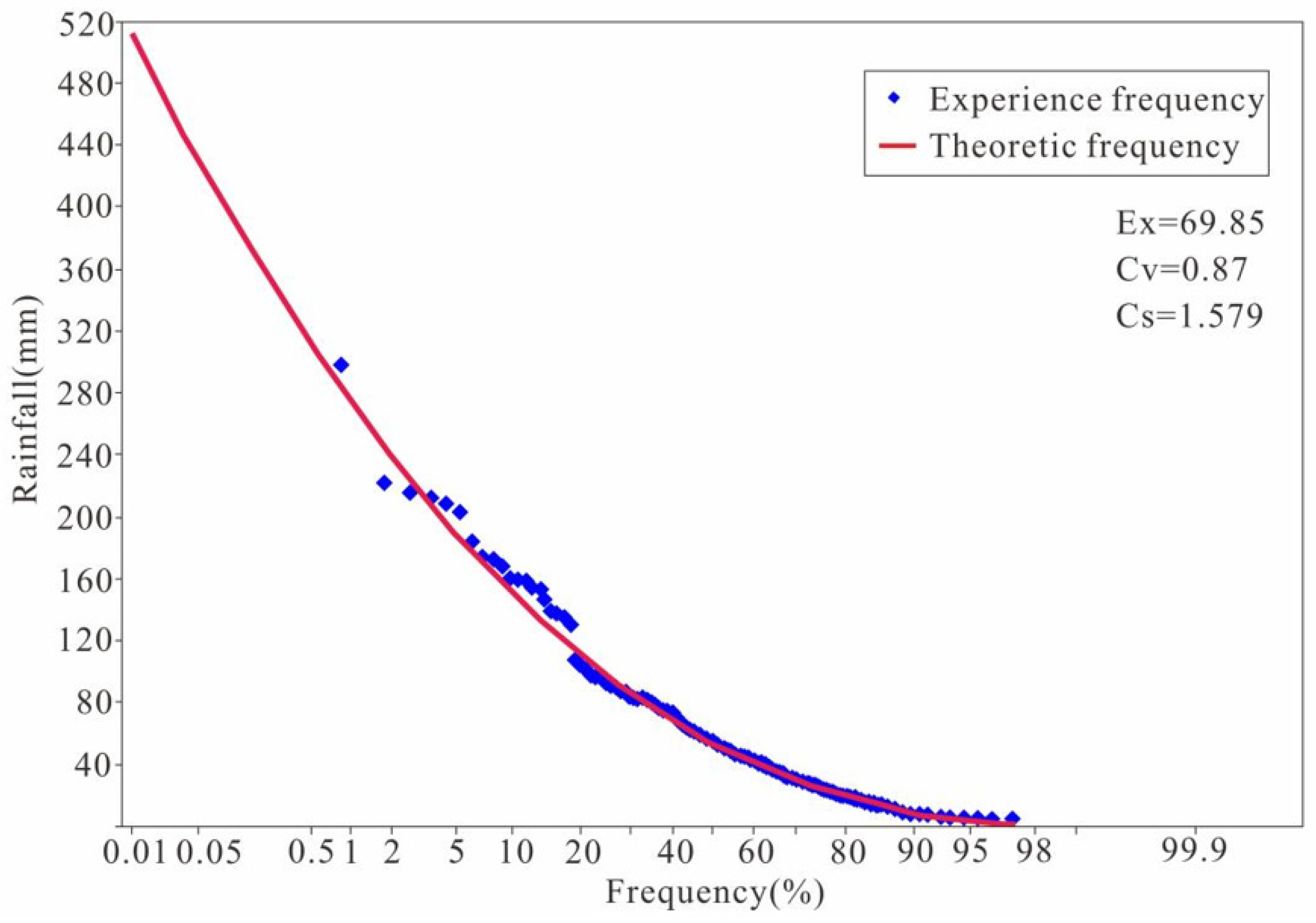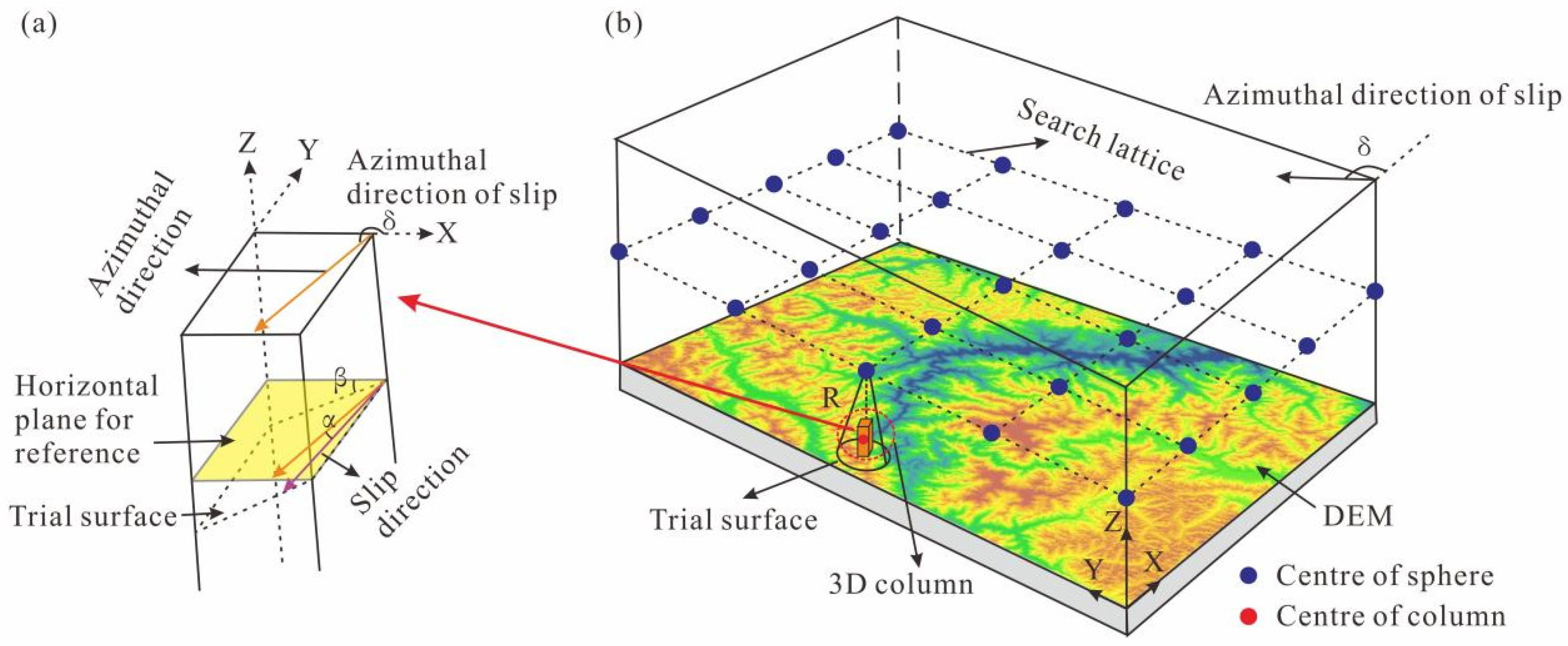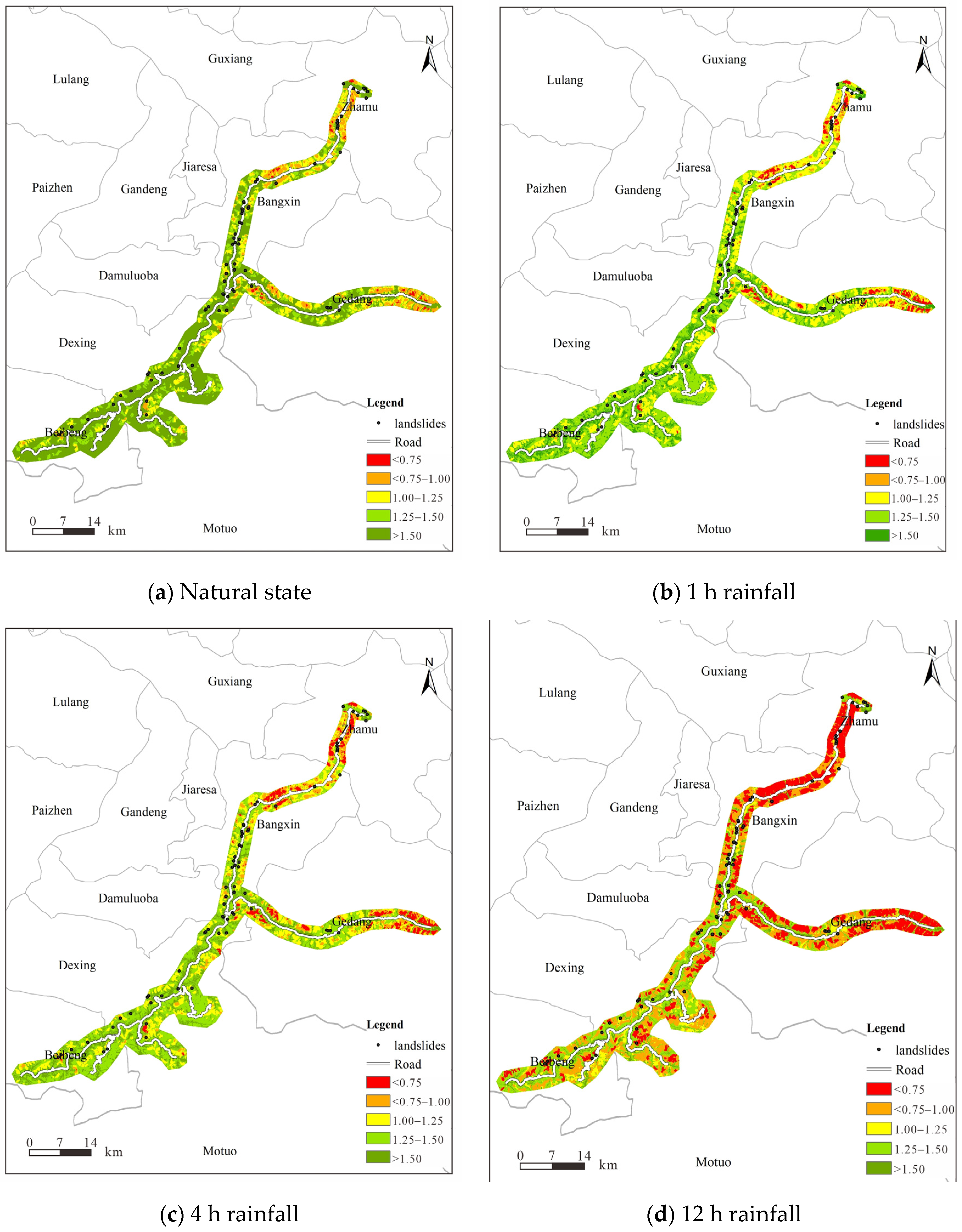Spatio-Temporal Prediction of Three-Dimensional Stability of Highway Shallow Landslide in Southeast Tibet Based on TRIGRS and Scoops3D Coupling Model
Abstract
:1. Introduction
2. Study Area and Data
2.1. Geotechnical Parameters
2.2. Spatial Distribution of Soil Thickness
2.3. Rainfall Information
3. Methods
3.1. Transient Rainfall Infiltration and Grid-Based Regional Slope-Stability Model
3.2. Three-Dimensional Slope-Stability Model
3.3. Coupling Model of TRIGRS and Scoops3D Model
4. Results and Discussion
4.1. Spatiotemporal Assessment of Shallow Landslides
4.2. Evaluation of Model Accuracy
5. Discussion
6. Conclusions
Author Contributions
Funding
Data Availability Statement
Acknowledgments
Conflicts of Interest
References
- Li, Z. Analysis and Countermeasures of Tibet Trunk Highway’s Geological Disasters. Master’s Thesis, Chongqing Jiaotong University, Chongqing, China, 2011. [Google Scholar]
- He, J.; Qiu, H.; Qu, F.; Hu, S.; Yang, D.; Shen, Y.; Zhang, Y.; Sun, H.; Cao, M. Prediction of spatiotemporal stability and rainfall threshold of shallow landslides using the TRIGRS and Scoops3D models. Catena 2021, 197, 104999. [Google Scholar] [CrossRef]
- Ma, C.; Liu, Z. Horizontal displacements and stability analysis of infinite slopes under rainfall infiltration. Rock Soil Mech. 2007, 28 (Suppl. S1), 563–568. [Google Scholar]
- Montgomery, D.R.; Dietrich, W.E. A physically based mode far the topographic control on shallow landslides. Water Resour. Res. 1994, 30, 1153–1171. [Google Scholar] [CrossRef]
- Wu, W.M.; Sidle, R.C. A distributed slope stability model for sheep forested basins. Water Resour. Res. 1995, 31, 2097–2110. [Google Scholar] [CrossRef]
- Pack, R.T.; Tarboton, D.G.; Goodwin, C.N. The SINMAP approach to terrain stability mapping. In Proceedings of the 8th Congress of the International Association of Engineering Geology, Vancouver, BC, Canada, 21–25 September 1998; pp. 21–25. [Google Scholar]
- Iverson, R.M. Landslide triggering by rain infiltration. Water Resour. Res. 2000, 36, 1897–1910. [Google Scholar] [CrossRef]
- Baum, R.L.; Savage, W.Z.; Gout, J.W. TRIGRS-A Form Program Far Transient Rainfall Infiltration and Grid-Based Regional Slope-Stability Analysis, Version 2.0; Open-File Report; USGS: Lakewood, CO, USA, 2008. [Google Scholar]
- Rossi, G.; Catani, F.; Leoni, L.; Segoni, S.; Tofani, V. HIRESSS: A physically based slope stability simulator for HPC applications. Nat. Hazards Earth Syst. Sci. 2013, 13, 151–166. [Google Scholar] [CrossRef]
- Cho, S.E. Prediction of shallow landslide by surficial stability analysis considering rainfall infiltration. Eng. Geol. 2017, 231, 126–138. [Google Scholar] [CrossRef]
- Zheng, L.; Li, X.; Yao, J.; Yu, W. Dynamic prediction of spatiotemporal stability of potential landslides based on the TRIGRS and Scoops3D coupling model. J. Nat. Disasters 2023, 32, 199–210. [Google Scholar]
- Reid, M.E.; Christian, S.B.; Brien, D.L.; Henderson, S.T. Scoops3D Software to Analyze 3D Slope Stability throughout a Digital Landscape; USGS: Reston, VA, USA, 2015; pp. 1–218. [Google Scholar]
- Brien, D.L.; Reid, M.E. Modeling 3D Slope Stability of Coastal Bluffs Using 3D Ground-Water Flow, South-Western Seattle, Washington; U.S. Geological Survey: Reston, VA, USA, 2007; pp. 1–54. [Google Scholar]
- Xin, X.; Zhang, F. The application of three-dimensional deterministic models in predicting the stability of shallow loess landslides. J. Eng. Sci. 2018, 40, 397–406. [Google Scholar]
- Zhang, S.; Wang, F. Three-dimensional seismic slope stability assessment with the application of Scoops3D and GIS: A case study in Atsuma, Hokkaido. Geoenvironmental. Disasters 2019, 6, 9. [Google Scholar] [CrossRef]
- Zhuang, J.; Peng, J.; Wang, G.; Iqbal, J.; Wang, Y.; Li, W.; Xu, Q.; Zhu, X. Prediction of rainfall-induced shallow landslides in the Loess Plateau, Yan’an, China, using the TRIGRS model. Earth Surf. Proc. Land. 2017, 42, 915–927. [Google Scholar] [CrossRef]
- Weidner, L.; DePrekel, K.; Oommen, T.; Vitton, S. Investigating large landslides along a river valley using combined physical, statistical, and hydrologic modeling. Eng. Geol. 2019, 259, 105169. [Google Scholar] [CrossRef]
- Alvioli, M.; Lee, G.; An, H.U. Three-dimensional, time-dependent modeling of rainfall-induced landslides over a digital landscape: A case study. Landslides 2018, 15, 1071–1084. [Google Scholar]
- Yao, J.; Li, X.; Xu, R. Dynamic Identification of Three-dimensional Stability of Potential Landslides in a Typical Section of the Proposed Sichuan-Tibet Railway under Rainfall Conditions. J. Disaster Prev. Mitig. Eng. 2021, 41, 422–431. [Google Scholar]
- Tran, T.V.; Alvioli, M.; Hoang, V.H. Description of a complex, rainfall-induced landslide within a multi-stage three-dimensional model. Nat. Hazards 2022, 110, 1953–1968. [Google Scholar] [CrossRef]
- Qi, S.; Li, Y.; Song, S.; Lan, H.; Ma, F.; Li, Z.; Chen, X.; Cui, Z.; Zhang, L.; Liu, C. Analysis of engineering geological stability zoning and distribution of engineering disturbance hazards in the Qinghai Tibet Plateau. J. Eng. Geol. 2022, 30, 599–608. [Google Scholar]
- Qu, S.; Zhao, J.; Ding, X.; Xie, M.; Bu, F.; Wang, J.; Liao, Y. Discrete element simulation of rainfall induced shelving bedding landslides. J. Hydrogeol. Eng. Geol. 2016, 43, 120–126. [Google Scholar]
- Wu, C. Evaluation of Geological Hazard Risk Based on Geological Information System in Nyingchi Section of Sichuan-Tibet Railway. Master’s Thesis, Tibet University, Lhasa, China, 2021. [Google Scholar]
- Li, R. Study on the Microphysical Characteristics of Precipitation Mêdog, South-Eastern Tibetan Plateau. Master’s Thesis, Chinese Academy of Meteorological Sciences, Beijing, China, 2023. [Google Scholar]
- Claessens, L.; Heuvelink, G.B.M.; Schoorl, J.M.; Veldkamp, A. DEM resolution effects on shallow landslide hazard and soil redistribution modeling. Earth Surface Process. Landforms 2005, 30, 461–477. [Google Scholar] [CrossRef]
- Bui, D.T.; Tsangaratos, P.; Nguyen, V.-T.; Van Liem, N.; Trinh, P.T. Comparing the prediction performance of a Deep Learning Neural Network model with conventional machine learning models in landslide susceptibility assessment. Catena 2020, 188, 104426. [Google Scholar] [CrossRef]
- Sarma, C.P.; Dey, A.; Krishna, A.M. Influence of digital elevation models on the simulation of rainfall-induced landslides in the hillslopes of Guwahati, India. Eng. Geol. 2020, 268, 105523. [Google Scholar] [CrossRef]
- Liu, Q. Analysis And Assessment of Rock Slope Stability in Zha Mo Road of Tibet. Master’s Thesis, Xi’an University of Science and Technology, Xi’an, China, 2008. [Google Scholar]
- Gu, T.; Wang, J.; Lu, X.; Meng, Y. Characteristics and stability analysis of accumulations landslide No. 3 in Tuoba of Southeast Tibet. J. Nat. Disasters 2009, 18, 32–38. [Google Scholar]
- Dai, X.; Zhao, J.; Lai, Q.; Wan, X.; Chen, K.; Wang, D. Movement process and formation mechanism of rock avalanche in Chada, Tibet Plateau. Earth Sci. 2022, 47, 1932–1944. [Google Scholar]
- Jin, J.; Zhong, Y.; Lv, G. Coupled Field Analysis of Alluvial River Bank Seepage Under Rainfall Infiltration. In Industrial Architecture Magazine: Collected Papers of the 2022 Industrial Architecture Academic Exchange Conference; Industrial Construction Magazine: Beijing, China, 2022; pp. 1066–1070. [Google Scholar]
- Nan, K. Research on Engineering Geological Characteristics and Engineering Effects of Deep Overburden in an Airport Field Area on the Southern Edge of the Qinghai-Tibet Plateau. Master’s Thesis, Chengdu University of Technology, Chengdu, China, 2021. [Google Scholar]
- Tao, W. Study on Stability and Rainfall Threshold of Typical Sandy Soil Slope in G318 Bomi-Nyingchi Section. Master’s Thesis, Tibet University, Lhasa, China, 2022. [Google Scholar]
- Pei, X.; Li, J. Study on soil erosion characteristics of excavated slopes with different gravel grinding roundness on PAI-Mo highway, Tibet. J. Geol. Hazards Environ. 2022, 33, 1–11. [Google Scholar]
- Ma, S. The Distribution Characteristics and Hazard Assessment of Landslide Under Various Earthquake and Rainfall Scenarios. Ph.D. Thesis, Institute of Geology, China Earthquake Administration, Beijing, China, 2022. [Google Scholar]
- Tesfa, T.K.; Tarboton, D.G.; Chandler, D.G.; McNamara, J.P. Modeling soil depth from topographic and land cover attributes. Water Resour. Res. 2009, 45, 10438. [Google Scholar] [CrossRef]
- Salciarini, D.; Godt, J.W.; Savage, W.Z.; Conversini, P.; Baum, R.L.; Michael, J.A. Modeling regional initiation of rainfall-induced shallow landslides in the eastern Umbria Region of central Italy. Landslides 2006, 3, 181–194. [Google Scholar] [CrossRef]
- Pelletier, J.D.; Rasmussen, C. Geomarphically based predictive mapping of soil thickness in upland watershedls. Water Resour. 2009, 45, 1–15. [Google Scholar]
- Alvioli, M.; Baum, R.L. Parallelization of the TRIGRS model for rainfall-induced landslides using the message passing interface. Environ. Model. Softw. 2016, 81, 122–135. [Google Scholar] [CrossRef]
- Viet, T.T.; Lee, G.; Thu, T.M.; An, H.U. Effect of digital elevation model resolution on shallow landslide modeling using TRIGRS. Nat. Hazards Rev. 2017, 18, 04016011. [Google Scholar] [CrossRef]
- Li, K. Research on the Stability of Road Slope Base on RBF Neural Network—Take the Shallow Slope of the K85 Section in Xia Bi Road of Tibet for Example. Master’s Thesis, Chang’an University, Chang’an, China, 2010. [Google Scholar]
- Zhang, X.; Zeng, C.; Zhang, F.; Yang, Z. Spatial Distribution of Soil Saturated Hydraulic Conductivity and Soil Bulk Density in a Typical Catchment in Southeast Tibet. J. Soil Water Conserv. 2012, 28, 69–73. [Google Scholar]
- Cen, X.; Xiao, X.; Cai, G.; Yang, S.; Zhang, J.; Wang, X.; Huang, Y. Experimental study on rainfall and discharge under the change of hydraulic gradient. Hydropower 2016, 42, 7–11. [Google Scholar]
- Li, K.; Zhang, M.; Xing, A. Process simulation and movement characteristics analysis of landslide debris flow in Sedongpu gully of the Yarlung Zangbo River. Chin. J. Geol. Hazard Control 2021, 32, 18–27. [Google Scholar]
- Deng, M.; Chen, N.; Wang, T.; Ding, H. The fluctuation of daily rainfall extremes in southeastern Tibet. J. Nat. Disasters 2017, 26, 152–159. [Google Scholar]
- Sun, D.; Zhang, Z.; Gao, Y.; Chen, B. Determination of basic parameters of SWCC for clayer soils. J. Shanghai Univ. 2019, 25, 957–964. [Google Scholar]
- Sun, D. Mechanical properties and constitutive model of unsaturated soil. Chin. J. Geotech. Eng. 2023, 45, 1–23. [Google Scholar]
- Peng, F.; Sun, D.A.; Yao, Y.; Tan, Y. Effect of granular structure and initial suction on shear strength of GMZ bentonite for deep geological disposal. Appl. Clay Sci. 2024, 249, 107249. [Google Scholar] [CrossRef]
- Wen, J. Regional rainfall landslide risk assessment based on Scoops 3D and TRIGRS Models—Taking a typical location in Wudu District, Longnan as an Example. Master’s Thesis, China University of Geosciences, Beijing, China, 2019. [Google Scholar]
- Teixeira, M.; Bateira, C.; Marques, F.; Vieira, B. Physically based shallow translational landslide susceptibility analysis in Tibo catchment, NW of Portugal. Landslides 2014, 12, 455. [Google Scholar] [CrossRef]
- Huang, C.C.; Tsai, C.C. New method for 3D and asymmetrical slope stability analysis. J. Geotech. Geoenviron. Eng. 2000, 126, 917–927. [Google Scholar] [CrossRef]
- Chakraborty, A.; Goswami, D. State of the Art: Three dimensional (3D) slope stability analysis. Int. J. Geotech. Eng. 2016, 10, 493–498. [Google Scholar] [CrossRef]
- Tarolli, P.; Tarboton, D.G. A new method for determination of most likely landslide initiation points and the evaluation of digital terrain model scale in terrain stability mapping. Hydrol. Earth Syst. Sci. 2006, 10, 663–677. [Google Scholar] [CrossRef]
- Mahalingam, R.; Olsen, M.J. Evaluation of the influence of source and spatial resolution of DEMs on derivative products used in landslide mapping. Geomat. Nat. Hazards Risk 2016, 7, 1835–1855. [Google Scholar] [CrossRef]
- He, S. Evaluation of Slope Stability in Northeastern Margin of Tibetan Plateau Based On Scoops3D Model—A Case Study of Jiajiagou. Master’s Thesis, Northwest University, Xi’an, China, 2022. [Google Scholar]
- Borga, M.; Fontana, G.D.; Gregoretti, C.; Marchi, L. Assessment of shallow landsliding by using a physically based model of hillslope stability. Hydrol. Process. 2002, 16, 2833. [Google Scholar] [CrossRef]
- Zhang, J.S.; Xu, M.; Zhang, Q.; Jihong, Q.; Wang, Y.S.; Xia, Q. Estimating groundwater runoff modulus method based on remote sensing in mountainous areas of Southeast Tibet. Earth Sci. 2022, 47, 642–651. [Google Scholar]








| Rock and Soil Mass | Cohesion c/kPa | Internal Friction Angle φ/(°) | Unit Weight of Soil γ/(kN/m3) | Unit Weight of Soil γw/(kN/m3) | Saturated Soil Water Content θs/% | Residual Soil Water Content θr/% |
|---|---|---|---|---|---|---|
| Soil layer | 10 | 25 | 20 | 9.8 | 72.5 | 5 |
| Bedrock weathering layer | 45 | 40 | 22 | 9.8 | 38 | 3 |
| Stability Classification | Safety Factor Range | Stability Partition |
|---|---|---|
| 1 | Fs < 0.75 | Extremely unstable area |
| 2 | 0.75 ≤ Fs < 1 | Unstable area |
| 3 | 1 ≤ Fs < 1.25 | Basically stable area |
| 4 | 1.25 ≤ Fs < 1.5 | Stable area |
| 5 | 1.5 ≤ Fs | extremely stable area |
| Disaster Scenarios | Safety Factor | Number of Landslides | % of Landslides | % of Predicted Area | LRclass | %LRclass |
|---|---|---|---|---|---|---|
| Natural state | Fs < 0.75 | 1 | 1.37 | 0.84 | ||
| 0.75 ≤ Fs < 1 | 7 | 9.59 | 8.08 | 1.23 | 55.66 | |
| 1 ≤ Fs < 1.25 | 17 | 23.29 | 13.82 | |||
| 1.25 ≤ Fs < 1.5 | 12 | 16.44 | 14.86 | |||
| 1.5 ≤ Fs | 36 | 49.32 | 62.39 | 0.98 | 44.34 | |
| 1 h rainfall | Fs < 0.75 | 3 | 4.11 | 3.62 | ||
| 0.75 ≤ Fs < 1 | 4 | 5.48 | 3.92 | 1.27 | 56.70 | |
| 1 ≤ Fs < 1.25 | 31 | 42.47 | 25.42 | |||
| 1.25 ≤ Fs < 1.5 | 29 | 39.73 | 41.88 | |||
| 1.5 ≤ Fs | 6 | 8.22 | 25.17 | 0.97 | 43.30 | |
| 4 h rainfall | Fs < 0.75 | 7 | 9.59 | 5.54 | ||
| 0.75 ≤ Fs < 1 | 4 | 5.48 | 8.43 | 1.08 | 52.17 | |
| 1 ≤ Fs < 1.25 | 28 | 38.36 | 21.73 | |||
| 1.25 ≤ Fs < 1.5 | 28 | 38.36 | 39.2 | |||
| 1.5 ≤ Fs | 6 | 8.22 | 25.1 | 0.99 | 47.83 | |
| 12 h rainfall | Fs < 0.75 | 24 | 32.88 | 22.09 | ||
| 0.75 ≤ Fs < 1 | 25 | 34.25 | 21.31 | 1.55 | 73.81 | |
| 1 ≤ Fs < 1.25 | 13 | 17.81 | 16.96 | |||
| 1.25 ≤ Fs < 1.5 | 9 | 12.33 | 28.36 | |||
| 1.5 ≤ Fs | 2 | 2.74 | 14.06 | 0.55 | 26.19 |
| Safety Factor | Number of Landslides | % of Landslides | % of Predicted Area | LRclass | %LRclass | |||||
|---|---|---|---|---|---|---|---|---|---|---|
| 3D | 1D | 3D | 1D | 3D | 1D | 3D | 1D | 3D | 1D | |
| Fs < 1 | 54 | 34 | 74 | 46 | 43.40 | 50.57 | 1.71 | 0.91 | 78.80 | 45.50 |
| Fs ≥ 1 | 19 | 39 | 26 | 54 | 56.60 | 49.43 | 0.46 | 1.09 | 21.20 | 54.50 |
Disclaimer/Publisher’s Note: The statements, opinions and data contained in all publications are solely those of the individual author(s) and contributor(s) and not of MDPI and/or the editor(s). MDPI and/or the editor(s) disclaim responsibility for any injury to people or property resulting from any ideas, methods, instructions or products referred to in the content. |
© 2024 by the authors. Licensee MDPI, Basel, Switzerland. This article is an open access article distributed under the terms and conditions of the Creative Commons Attribution (CC BY) license (https://creativecommons.org/licenses/by/4.0/).
Share and Cite
Mao, J.; Ma, X.; Wang, H.; Jia, L.; Sun, Y.; Zhang, B.; Zhang, W. Spatio-Temporal Prediction of Three-Dimensional Stability of Highway Shallow Landslide in Southeast Tibet Based on TRIGRS and Scoops3D Coupling Model. Water 2024, 16, 1207. https://doi.org/10.3390/w16091207
Mao J, Ma X, Wang H, Jia L, Sun Y, Zhang B, Zhang W. Spatio-Temporal Prediction of Three-Dimensional Stability of Highway Shallow Landslide in Southeast Tibet Based on TRIGRS and Scoops3D Coupling Model. Water. 2024; 16(9):1207. https://doi.org/10.3390/w16091207
Chicago/Turabian StyleMao, Jiarui, Xiumin Ma, Haojie Wang, Liyun Jia, Yao Sun, Bin Zhang, and Wenhui Zhang. 2024. "Spatio-Temporal Prediction of Three-Dimensional Stability of Highway Shallow Landslide in Southeast Tibet Based on TRIGRS and Scoops3D Coupling Model" Water 16, no. 9: 1207. https://doi.org/10.3390/w16091207




